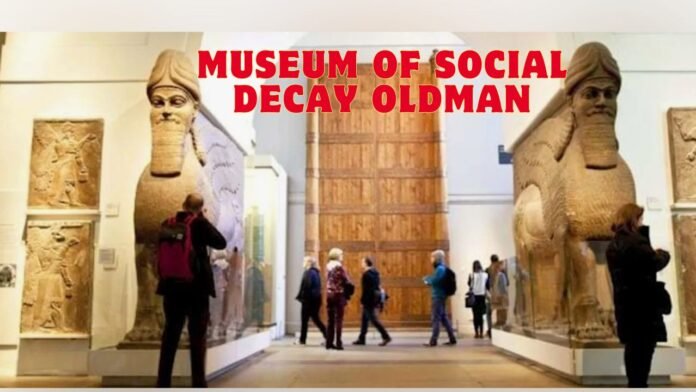Museum Of Social Decay Oldman lies in its unique approach to preserving history. It encapsulates the essence of societal decline through the lens of aging structures and fading memories, offering visitors a poignant reflection on the passage of time and the resilience of human civilization.
Social Decay
Social decay encapsulates the gradual degradation of societal values, structures, and norms. It emerges from many interconnected factors, including economic instability, political unrest, environmental degradation, and cultural shifts.
Visible signs of social decay manifest in abandoned buildings, neglected communities, and fraying social bonds. The concept highlights the erosion of social cohesion and the breakdown of institutions that once formed the backbone of communities.
Understanding social decay is essential for comprehending modern society’s challenges and devising strategies to address them effectively. It underscores the importance of preserving history and learning from past mistakes to build a more resilient and sustainable future.
The Concept of “Museum of Social Decay”
The “Museum of Social Decay” concept revolves around preserving and exploring societal decline through tangible artefacts and structures. These museums serve as custodians of history, offering visitors a poignant reflection on the fragility of human civilization.
By showcasing abandoned buildings, neglected neighbourhoods, and other remnants of societal decay, these institutions provide insight into the complex factors contributing to social decline.
Moreover, they stimulate critical reflection on the consequences of neglect and indifference, prompting individuals to consider their role in shaping the future.
Through curated exhibits and immersive experiences, museums of social decay foster empathy, understanding, and appreciation for the intricate tapestry of human existence.
Oldman: A Unique Perspective
“Oldman: A Unique Perspective” offers a distinctive lens through which to view societal decay. This keyword evokes imagery of ageing structures, faded memories, and the passage of time.
It encapsulates the essence of nostalgia and reflects on the resilience of human civilization amidst the inevitable march of progress. Through the concept of “Oldman,” museums of social decay aim to capture the essence of bygone eras and preserve them for posterity.
It prompts reflection on the transient nature of existence and the enduring legacy of the past. In essence, “Oldman” represents a poignant reminder of our shared history and the lessons it imparts for the future.
Historical Context and Relevance
Museum of social decay oldman, historical context provides invaluable insight into the events, cultures, and ideologies that have shaped the world we live in today. By examining the past critically, we gain a deeper understanding of contemporary issues and trends.
Understanding historical context is essential for making informed decisions, fostering empathy, and building a more inclusive society. Moreover, recognizing the relevance of history helps us appreciate the complexities of human experience and avoid repeating past mistakes.
Historical context is a guiding light, illuminating the path towards a brighter and more enlightened future.
Preserving History Through Museums
Preserving history through museums is an indispensable endeavour to safeguard cultural heritage for present and future generations. Museums serve as custodians of the past, meticulously cataloguing and curating artefacts to ensure their longevity and accessibility.
By showcasing historical objects and narratives, these institutions offer invaluable insights into the diverse facets of human civilization. Through immersive exhibits, guided tours, and educational programs, museums engage audiences of all ages and backgrounds, fostering a deeper appreciation for the richness and complexity of our collective heritage.
Preserving history through museums is a vital means of connecting with our roots, fostering cultural understanding, and nurturing a sense of identity and belonging.
Impact on Contemporary Society
Museum of social decay oldman, the impact of social decay on contemporary society is profound and far-reaching. As communities grapple with the consequences of deteriorating infrastructure, economic instability, and social disintegration, the fabric of society is increasingly frayed.
This erosion of social cohesion has significant implications for public health, crime rates, and overall quality of life. Moreover, the prevalence of social decay can exacerbate existing inequalities, widening the gap between the haves and the have-nots.
In response, policymakers, activists, and community leaders must work collaboratively to address the root causes of social decay and foster inclusive, resilient communities that prioritize the well-being of all residents.
Challenges in Preserving Social Decay
Navigating the obstacles inherent in preserving social decay presents a multifaceted challenge. Financial constraints often impede conservation efforts, limiting resources available for maintenance and restoration.
Logistical complexities further complicate preservation, requiring meticulous planning and coordination among stakeholders. Ethical considerations also arise, particularly regarding issues of gentrification and cultural appropriation.
Balancing the imperative to conserve with the demands of progress poses a constant dilemma, as preserving decaying structures may conflict with urban development initiatives.
Addressing these challenges requires a holistic approach that prioritizes collaboration, innovation, and ethical stewardship, ensuring that the rich tapestry of human history remains accessible to future generations.
Revitalization Efforts
Revitalization efforts are proactive initiatives to breathe new life into deteriorating areas, urban neighborhoods, historical districts, or cultural landmarks. These endeavours seek to revitalize communities by addressing economic decline, population loss, and physical decay.
Revitalization efforts often involve a combination of strategies, including adaptive reuse of existing structures, infrastructure improvements, community engagement, and economic development incentives.
By harnessing the collective efforts of residents, businesses, and government entities, revitalization efforts aim to create vibrant, sustainable, and inclusive spaces that enhance quality of life, preserve cultural heritage, and stimulate economic growth.
Visitor Experience and Education
Visitor Experience and Education are central components of museums of social decay, offering engaging opportunities for learning and reflection. Through interactive exhibits, guided tours, and immersive storytelling, visitors are immersed in the rich history of societal decline.
These experiences foster a deeper understanding of the factors contributing to social decay and prompt critical thinking about their implications for contemporary society. By engaging with exhibits, visitors gain insight into the complexities of human existence and are empowered to enact positive change in their communities.
Additionally, educational programs and workshops provide further learning and skill development opportunities, ensuring visitors have a newfound appreciation for history and a desire to effect meaningful change.
The Ethical Debate
The Ethical Debate surrounding social decay preservation centers on the delicate balance between honouring the past and embracing progress. It raises complex questions about the ethical implications of conserving decaying structures, particularly in the face of urban development pressures.
Advocates for preservation argue that maintaining historical integrity honours the legacy of communities and fosters a deeper understanding of societal evolution. However, opponents contend that prioritizing preservation may impede progress and economic growth, leading to debates over the equitable distribution of resources and the preservation of cultural identity.
Finding a consensus requires navigating competing interests while upholding ethical principles and preserving cultural heritage.
Future Prospects
As we look ahead to the future, the trajectory of museums of social decay appears promising and dynamic. Innovation in technology, sustainability, and community engagement is poised to revolutionize these institutions’ operations.
Advancements such as virtual reality tours and interactive exhibits offer immersive experiences for visitors, bringing history to life in unprecedented ways. Furthermore, a growing emphasis on sustainability and environmental conservation drives efforts to repurpose decaying structures in eco-friendly ways.
By embracing these trends and remaining adaptable to change, museums of social decay are well-positioned to continue inspiring curiosity, fostering empathy, and preserving history for future generations.
The Oldman Museum
The Oldman Museum is a testament to the passage of time, offering a captivating journey through history’s intricate tapestry. Nestled within its hallowed halls are relics and artifacts that whisper tales of bygone eras, each one a testament to the enduring spirit of human endeavor.
From weathered manuscripts to crumbling architectural marvels, the museum’s exhibits offer a poignant reflection on the ebb and flow of civilizations.
Visitors are invited to embark on a voyage of discovery, delving into the depths of antiquity and emerging with a newfound appreciation for the rich tapestry of human heritage preserved within the Oldman Museum’s hallowed walls.
museum of Social Decay Oldman crossword clue
The clue “museum of social decay old man crossword clue” hints at a thematic intersection between the concept of a museum dedicated to social decay and the term “old man.” This suggests a puzzle or game scenario where participants must decipher the connection between a museum showcasing societal decline and the inclusion of the term “old man.”
The challenge may involve unraveling the significance of aging structures or artifacts within the context of social deterioration. Ultimately, solving the crossword clue likely requires understanding the symbolic relevance of “old man” within the broader theme of preserving history amidst societal decay.
Conclusion
The “Museum of Social Decay Old Man” represents a vital endeavor in documenting and commemorating the complexities of human existence. Preserving decaying structures and artifacts serves as a testament to the intricacies of societal evolution, offering valuable insights and prompting reflection on the past, present, and future.
FAQ
Is the Museum of Social Decay According To Gary Oldman?
No, the Museum of Social Decay is not affiliated with Gary Oldman. The term “Oldman” in this context refers to the aging and deterioration of societal structures and norms, rather than being related to the actor Gary Oldman in any way.
What is The Museum of Death Content?
The Museum of Death features exhibits related to various aspects of death, including historical artifacts, forensic pathology, serial killers, and controversial topics surrounding mortality. Visitors can explore displays of crime scene photographs, autopsy instruments, and other morbid curiosities, offering a unique and thought-provoking experience.
Who Founded The Museum Of Failure And Why?
The Museum of Failure was founded by Dr. Samuel West, a clinical psychologist based in Sweden. Dr. West established the museum with the aim of celebrating innovation and learning from past mistakes. He believed that failure plays a crucial role in the process of innovation and wanted to create a space where people could explore and understand the concept of failure in a lighthearted and educational manner.


